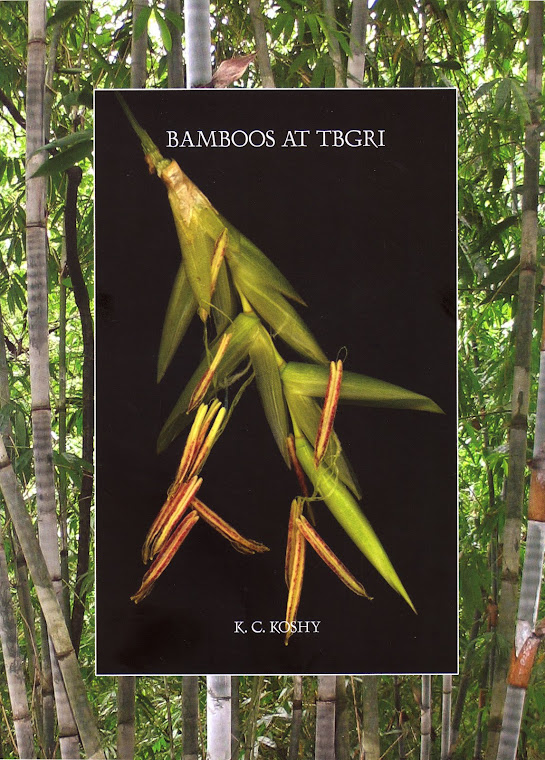N E L U M B O Vol.52: 156 .2010
BOOK REVIEW
Bamboos at TBGRI by K.C. Koshy. Tropical Botanic Garden and Research Institute, Palode, Thiruvananthapuram-695562, Kerala, India. 2010. pp. 104. Paper back edition. ISBN: 978-81-920098-0-3, Price: 800, US $ 30.
The monumental and comprehensive work of J.S.Gamble form the basesline for advancement of Bamboo studies in India. Even after the lapse of over a hundred years, this work is extensively used in India and South East Asia, not only by taxonomists and foresters but also by other specialists in morphology, biochemistry, molecular biology, anatomy and palynology.
The first post-independence exploratory work on bamboos in India was initiated at Forest Research Institute, Dehradun and Botanical Survey of India at Kolkata and Shillong. Subsequently, several reports, research papers, catalogues and detailed taxonomic accounts on the grasses and bamboos from various parts of India have been published. Most of these publications give purely technical descriptions used by well trained taxonomists and usually lack good illustrations and colour photographs to aid field identification. Therefore, these books could not attract the attention of the general public, nature lovers and nurserymen towards bamboos. More recently, illustrated books on bamboos have been published for India (by Seethalakshmi & Kumar, Tiwari) and Assam (by Baruah & Borthakur). It is pertinent to note that during the last 50 years, the nomenclature of Indian bamboos has undergone major changes due to revisionary works and monographic studies throughout the world particularly in China and Malesia. However, there is no general agreement about the generic concept and identity of several species complexes in India.Only study of live material can help in untangling so many identity problems that Indian bamboos face. Botanic Gardens and Bambusetums can contribute in significant way in our understanding of bamboos.
The book under review- Bamboos at TBGRI by K.C. Koshy is a step in this direction and is very useful and informative book about the different species growing in the Bambusetum at TBGRI which are introduced from different regions of India and other countries, accounting for a large collection of live specimens of this unique group of plants.
The book containing 104 pages has been divided into three chapters. Chapter one deals with the establishment of the Bambusetum at TBGRI which explains the initiative taken by the author and the cooperation extended by different authorities & personalities for establishing the Bambusetum. Practical difficulties encountered in establishing this bambusetum and particularly excavation and transport of bulky rhizomes and propagules from Manipur and Arunachal Pradesh have been well presented by the author. In the second Chapter of the book, Bamboo resources at TBGRI are dealt under four categories – Live collections, Herbarium & Spirit collections, Museum specimens and Bamboo nursery. A detailed account of 68 species, 12 new hybrids and one variety under 15 genera is arranged alphabetically. It seems to be the largest collection of bamboos in any bambusetum in India. Each species is provided with correct name, synonyms, reference to major works, short description and distribution. The most important part of this chapter is information about the live accessions and different hereditary lines of each species raised and maintained in the Bambusetum and their exact location (which have been indicated on the Map) with planting date and province. This in addition is supplemented with the voucher number of dried specimens and spirit collections, thereby giving complete information about all the representing specimens of each species present at TBGRI.
Chapter three deals with the prospects of the bamboo cultivation for sustainable utilization and hybrid production for quality improvement.
The photographs provided for the species are excellent and helpful in identification of species but it would have been more useful if photographs of diagnostic characters and range of variation in different morphological parts were also given for their correct identification. Overall the author has presented the subject in a comprehensive way, though the book is lacking the identification key to the species, but author needs to be congratulated for developing one of the best bambusetums of modern times in this part of the world. It also clearly reflects how little we know about the bamboos and how difficult it is to identify this enigmatic group as there are 17 species in the book under Bambusa, Dendrocalamus and Ochlandra which are yet to be identified.
The book has been aesthetically designed and well printed and is a must for all bamboo lovers, though the price appears to be on the higher side.
PARAMJIT SINGH
Botanical Survey of India
Kolkata
